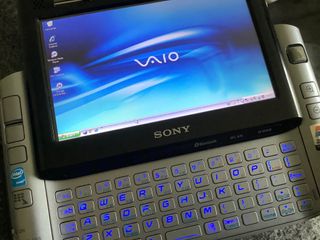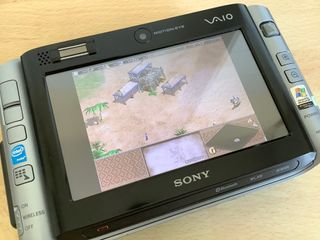16 years before the Steam Deck, Sony's Vaio UX was the coolest portable PC ever
A retro future beauty.

Isn't the Steam Deck an incredible piece of hardware? Just look at it, hanging around Steam's front page in all its matte black glory, promising those with copious patience and money modern PC gaming absolutely anywhere they dare take it. Valve's machine is a bold and beautiful thing: the present pinnacle of portable PC play, and the beginning of another generation in a long and haphazard family tree. Its roots are the chunky Game Boys and laptops of the '90s, but the Steam Deck's closest (or at least quirkiest) ancestor is Sony's now sixteen-year-old, but still astonishingly chic, Vaio UX.
The chicness of Sony's Vaios has always come at a cost—one so high that not even in my dual-wielding credit card phase did I dare order Sony's palm-sized PC. But the lust never faded? Imagine owning a really tiny computer, one so beautiful it was used in one of Daniel Craig's James Bond movies.
I've wanted one for years, so instead of buying some uncomfortably tight leather trousers and/or a dangerously fast motorbike for my 40th birthday, I splashed out on a Vaio UX instead. To say it has lived up to my own decade-plus of hype is an understatement.
Measuring roughly the same size and thickness as the original Game Boy, these exceptional devices all feature a slide up touchscreen with a full keyboard underneath—take that, frustratingly key-free 2022 tech. There's Bluetooth connectivity, wi-fi, a memory stick slot, front and rear cameras (complete with a shot button charmingly positioned exactly where you'd expect to find it on a real camera), and handwriting recognition. Dedicated mouse buttons on the left hand side of the chassis are designed to be used alongside the handy mouse nub sitting on the right. It's a truly self-contained, do-it-all-PC from the glory days of Windows XP.
The Vaio UX is the perfect time capsule gaming machine
The Vaio UX series manage to look beautiful whether at rest in their sleek dock bristling with additional ports, or held either horizontally (standard use) or vertically (intended to make reading web pages easier). So perfectly designed is Sony's long-discontinued hardware that I see echoes of its sleek shape in last year's GPD Win 3. They're solidly built, brilliantly functional, and effortlessly stylish—and they bloody well should be, considering Sony tended to sell them for an eye-watering $2,000 when they were new.
Just in case I haven't already made it obvious: I have never desired any amalgam of metal and plastic more than I have a Vaio UX. It was Sony's forbidden tech fruit, as impossibly unattainable to someone like me as the Aibo (the company's series of robot dogs) or more recently the PlayStation 5. I pawed at the postage stamp sized images used in online reviews and hastily scrolled past the inevitable "Nobody needs this, it's too expensive" comments in the writers' summaries. I needed it. I knew in my bones I needed it.



But what good is old tech in the age of the Steam Deck and ultralight laptops? Why waste time with a machine whose single-core processor and integrated Intel graphics chip were put together for the sake of "productivity on the go?" The Vaio UX was made to connect to a projector in a board meeting or be pulled out of a leather briefcase during the sort of private jet I imagine CEOs are always on, not to play games.
The biggest gaming news, reviews and hardware deals
Keep up to date with the most important stories and the best deals, as picked by the PC Gamer team.
The beauty of PCs is that they can be whatever the heck the person using them wants them to be, which in my case makes the Vaio UX the perfect time capsule gaming machine. No, it can't run Elden Ring, Halo Infinite, or even Stardew Valley. What it can run—and run surprisingly well via the comforting sights and sounds of Windows XP Professional—are the likes of Baldur's Gate, Wizardry 8, and Ys: The Oath in Felghana. The entirety of System Shock 2's slightly awkward controls are here for the wrangling on a real physical keyboard.
I can even sit in the garden and tap away at Age of Empires 2 or Sid Meier's Alpha Centauri using the Vaio's stylus until the battery runs out (which takes around two hours, depending on the game).
The UX's hard drive space (generally hovering around the 30 to 40GB mark, depending on the model) is woefully inadequate by modern standards—I know I've installed high resolution texture patches that'd easily swallow that up in one go. But when games from the Vaio UX's era sweetly warn you about their "enormous" 600MB install size, you soon realise there's more than enough room for everything you could wish for with plenty of space left over for a few DOS classics, too. I'm currently trying to save humanity against the alien menace in X-COM: UFO Defense—it's not going well.

Once I've loaded up my UX with the likes of Grim Fandango or indeed any other late '90s classics I've got scattered around my home the form factor really does make playing even the most familiar game feel brand new, as owners of the UX's modern descendants know all too well. There's a little awkwardness to the experience—none of these games were designed to be desk-free experiences played on 4.5 inch screens after all—but I'll happily put up with that for the sake of breathing fresh life into old files. And besides, tweaking the system settings exactly to your liking is half the fun of a new install, right?
I see playing games on the Vaio UX the same way I do choosing to buy an album on vinyl, even though millions of songs are a quick scroll away online. The act of interacting with this forever-niche branch of PC hardware, bringing out CDs to install, manually organising my little gaming folder, and getting everything tweaked just the way I like it is a huge part of the pleasure of it all. Maybe moreso, even, than actually getting a game I first played on a giant CRT monitor and an off-white tower running in the palm of my hand.
Vaio UXs are just fun. It's a pocket-sized PC I can play a personally curated selection of all-time classics on, a land where spam emails can never reach me and every boring system update was already sorted out permanently almost a decade ago.
They're so much fun I think everyone should give this unlikely combination of take-anywhere sit-down PC gaming a try, whether you're eager to play Sekiro in a field on the Steam Deck, have a burning desire to fill one of GPD's handhelds with emulators, or get misty eyed at the thought of all four of Planescape: Torment's CDs installed on a teenage Vaio. Handheld PC gaming may never go truly mainstream, but if this constantly resurfacing niche proves anything, it's that making the effort to do things a little differently can bring new joys out of old favourites.

When baby Kerry was brought home from the hospital her hand was placed on the space bar of the family Atari 400, a small act of parental nerdery that has snowballed into a lifelong passion for gaming and the sort of freelance job her school careers advisor told her she couldn't do. She's now PC Gamer's word game expert, taking on the daily Wordle puzzle to give readers a hint each and every day. Her Wordle streak is truly mighty.
Somehow Kerry managed to get away with writing regular features on old Japanese PC games, telling today's PC gamers about some of the most fascinating and influential games of the '80s and '90s.
Most Popular


